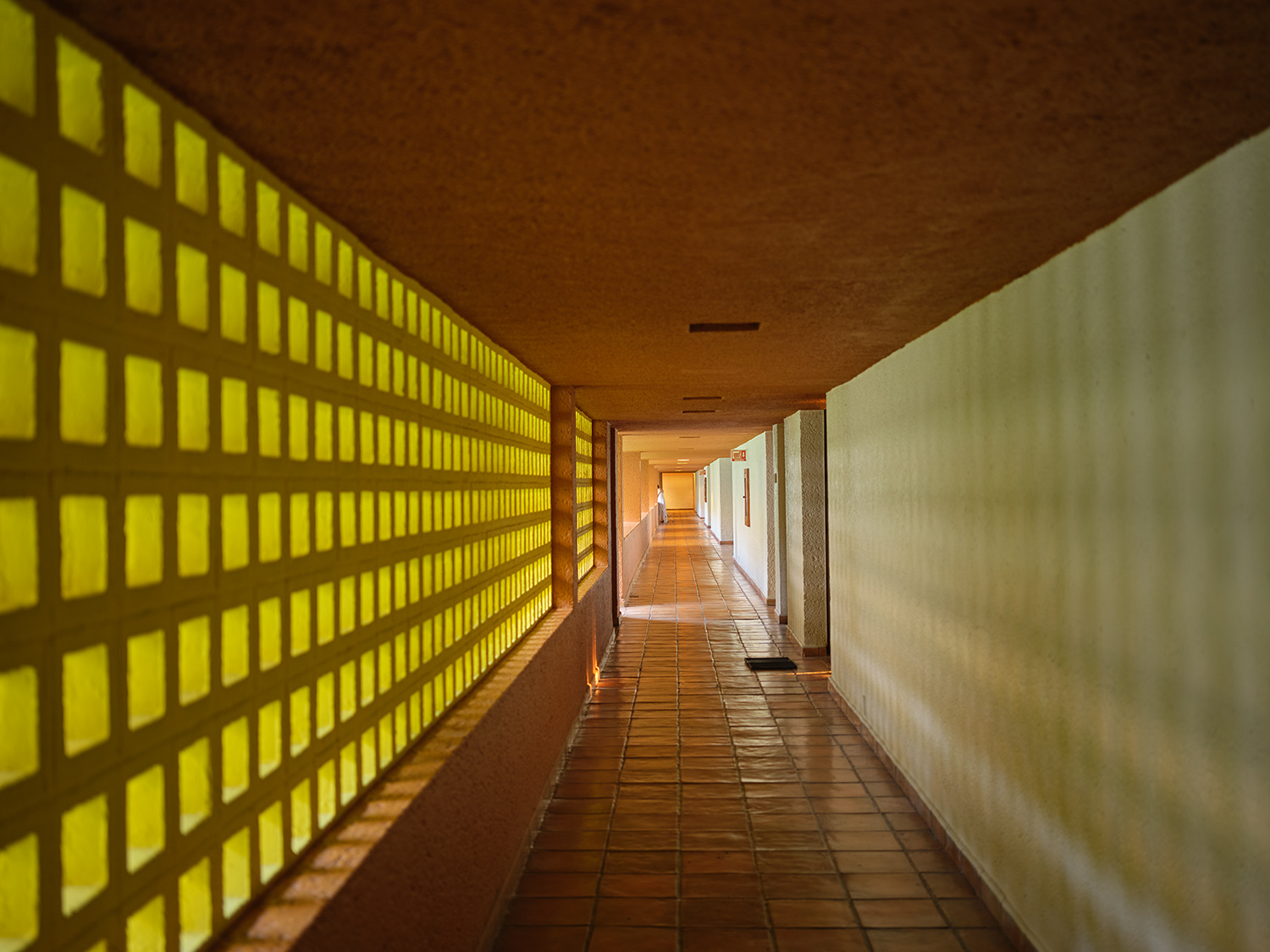LAS BRISAS IXTAPA, VERNACULAR POSTMODERNISM
Photography by Mauricio Guillén
Hotel Las Brisas Ixtapa (originally Camino Real) is one of the most important works of Mexican architect, Ricardo Legorreta. Inaugurated in 1981, it was the foundational landmark of the then developing touristic zone of Ixtapa, Mexico.
Located on the coast of Guerrero—some 3 hours north of Acapulco—Ixtapa was a government led effort to develop a zone of fishing villages and huge coconut plantations. Growing in the middle of nowhere, it soon became the elegant sister of Zihuatanejo, long known for its calm beaches and bohemian ambience.
Unlike Ixtapa, Zihuatanejo has a long history that dates back to pre-hispanic times and later hosted sea battles between the Spanish navy and British pirates, including Sir Francis Drake who spent some time there. Perhaps a lesser known historical moment took place in the summer of 1962 in the Playa de la Ropa when a group of 36 people led by psychologist and best known defender of LSD, Timothy Leary, took week-long acid trips while staying in Zihuatanejo’s hotel Catalina. An experiment partly inspired by Aldous Huxley’s book The Island. More recently, the famous hotel La Casa Que Canta was one of the settings of the 1994 alcoholism drama When a Man Loves a Woman, starring Andy Garcia and Meg Ryan.
Legorreta had been a loyal disciple of architect José Villagrán’s rational style as can be seen in the Celanese building of 1968, a structural prodigy of brutalist taints which unfortunately today are hidden by AstroTurf and polarized windows. Also in 1968, a year characterized by the Mexican Olympic Games and by sanguinary student repression, Legorreta had his first commission for Camino Real Hotels in Mexico City. It is in this hotel, where he begins to include traditional Mexican elements in his architecture by the use of different materials, colors and scale. This was evidence of his change of mentors, Luis Barragán and Mathias Goeritz, incorporating elements of their Critical Regionalism and Emotional Architecture into his work. Polanco’s Camino Real Hotel has great masterpieces by artists such as Anni Albers, Alexander Calder and Rufino Tamayo which are proof of the hotel’s relevance at the time. Camino Real commissioned Legorreta again for their hotel in Cancun in 1975 where certain novel elements are a clear precedent of what would later be seen with much greater strength in the Ixtapa project.
The main touristic zone of Ixtapa consists of a long beach lined by typical chain hotels of scant architectural value. Sitting directly behind this strip, is a fake Mexican village with restaurants and handicrafts, 80’s style fancy discotheques such as the well known Christine, relaxed bars with early 90’s hip-hop where you can still bump and grind, such as Sr. Frogs, or the Bogart’s, a famous restaurant-bar with obvious reminiscences of classy Casablanca. All are still there, creating a nostalgia of recent much better decades.
Las Brisas is slightly isolated from the main Ixtapa beach; it extends on a smaller bay featuring large waves and luscious vegetation. Although the color and size of the building are everything but discrete, they blend surprisingly well with the mountainous topography of its surroundings. To stay in the hotel is, by itself, a constant architectonic experience; every detail in the building has a forceful spatial intention impossible to ignore. The height of the ceilings in the reception, the never ending corridors, and the pharaonic stairways constantly remind you that this is not a conventional building. The extravagant color palette of the thick lumpy concrete walls perfectly merges with other classic elements typical of Legorreta constituting vision of a new Mexican style.
Inside, the large perfect grid of floor clay tiles evoke a rustic Superstudio moment interrupted by Legorreta’s furniture: huge tables with playful thick legs along with other smaller tables and benches with the same endearing, almost ridiculous, proportions appear along the lengthy trips between the different areas of the hotel. The hotel is gigantic and, although you can use lifts to move around, it is impossible to get to the second day without sore legs.
Among postmodern gestures and a scale closer to that of an airport than to a normal hotel, you can clearly feel the homage to Luis Barragán. A corridor of yellow lattice immediately transports you to Las Capuchinas Chapel, and the waterfalls of the swimming pools make a loving wink to la Fuente de los Amantes and Las Caballerizas.
The pathways between the beach and the hotel are intricate labyrinths where the only visual reference is a peculiar one floor elevator that emerges from the well kept jungle-like vegetation amidst the singing of birds.
The 416 guest rooms of the hotel keep a large part of the original furniture: benches with defiant thick legs and quasi monastic Barragan-esque beds along with green and blue wooden striped mirrors that bring to mind Carlos Cruz-Diez’s Op Art. All the rooms are crowned by characteristic sea-view yellow terraces that generate a perfect grid that can be seen from almost anywhere and increases in intensity towards midday when it becomes a facade of strict and fascinating geometries. At dusk, silhouettes become softer and the color of the building mimics the sunset.
Despite its 40 years and several changes in administration, the hotel is very well kept and has little modifications with respect to the original project: new additions on the furniture catalogue, a big art installation at the entrance of the bar and some explorations on new materials. Overall nothing can really distract from the constant stimulation of Legorreta’s design.
Special thanks to Las Brisas Ixtapa.










